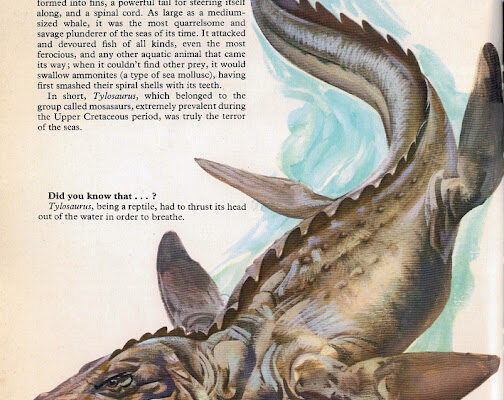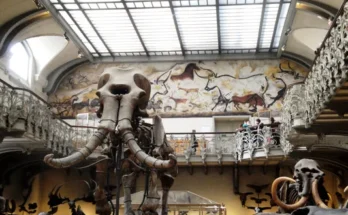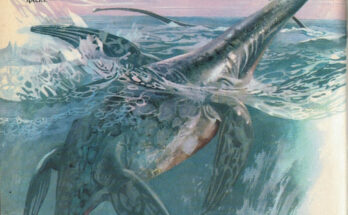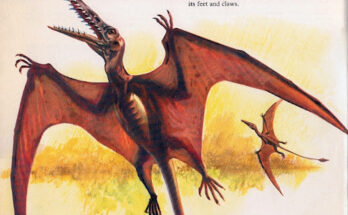Tylosaurus: A Comprehensive Tutorial on a Prehistoric Marine Reptile

Introduction
Tylosaurus, a formidable marine reptile of the Late Cretaceous period, dominated the ancient oceans approximately 85-80 million years ago. This tutorial provides an in-depth exploration of Tylosaurus, focusing on its anatomy, hunting strategies, and ecological role. Supported by detailed illustrations and scientific context, this guide is tailored for students, educators, and paleontology enthusiasts eager to uncover the mysteries of prehistoric marine life.
Overview of Tylosaurus
Tylosaurus was a giant mosasaur, a group of large marine lizards, reaching lengths of up to 14 meters (46 feet). The image showcases its elongated, streamlined body, powerful tail, and massive jaws filled with sharp, conical teeth. As one of the apex predators of its time, Tylosaurus swam with remarkable agility, using its paddle-like limbs and tail to pursue prey across the vast Cretaceous seas.
Anatomical Features
- Jaws and Teeth: The image highlights Tylosaurus’s robust skull and formidable teeth, designed to crush the shells of mollusks and grasp a variety of prey, including fish, ammonites, and even smaller marine reptiles. Its bite force was exceptional, making it a versatile hunter.
- Body Structure: With a streamlined body and four paddle-like limbs, Tylosaurus was well-adapted for aquatic life. The text notes its powerful tail, which served as a primary means of propulsion, enabling swift and efficient swimming.
- Respiratory Adaptations: The “Did You Know?” section reveals that Tylosaurus could thrust its head out of the water to breathe, a critical adaptation for a reptile that spent its life submerged but required air to survive.

Lifestyle and Behavior
Tylosaurus was an ambush predator, relying on its speed and strength to overpower prey. The text describes how it would attack with sudden lunges, using its tail to maneuver and its jaws to deliver a crushing bite. Its diet was diverse, including squid, fish, and even other mosasaurs, as evidenced by fossilized stomach contents. The image’s depiction of its menacing posture underscores its reputation as a terror of the seas, often preying on groups of marine animals with relentless efficiency.
Evolutionary Significance
As a mosasaur, Tylosaurus belongs to a lineage of marine reptiles that evolved from terrestrial lizards during the Cretaceous period. Its adaptations for aquatic life, such as the loss of external limbs in favor of paddles and enhanced swimming capabilities, highlight the remarkable evolutionary transition of reptiles to marine environments. Fossils found in North America, particularly in Kansas and South Dakota, provide valuable insights into its dominance and the biodiversity of the Western Interior Seaway.
Educational Applications
This tutorial is an excellent resource for teaching evolutionary biology, paleontology, and marine ecology. Educators can use the image to illustrate the adaptations of marine reptiles, the concept of apex predation, and the ecological dynamics of the Cretaceous period. Students can analyze Tylosaurus’s anatomy to explore how prehistoric species adapted to aquatic niches. The visual aid enhances interactive learning and encourages further research into mosasaur evolution.
Scientific Context
Fossil evidence of Tylosaurus, often discovered in the chalk deposits of the Niobrara Formation, includes complete skeletons with preserved soft tissue impressions. These fossils have allowed paleontologists to reconstruct its lifestyle and diet, revealing its role as a top predator in a thriving marine ecosystem. Ongoing studies continue to explore its relationship with other mosasaurs, enhancing our understanding of Late Cretaceous marine biodiversity.
Conclusion
Tylosaurus stands as a testament to the diversity and power of prehistoric marine reptiles, reigning as a dominant predator of the Cretaceous seas. This tutorial offers a thorough examination of its anatomy, behavior, and evolutionary role, supported by the vivid illustration provided. We encourage readers to explore additional resources on mosasaur evolution and the rich marine ecosystems of the Late Cretaceous to deepen their understanding of Earth’s ancient oceans.



